
Once More, with Feeling: Incorporating Emotion in Environmental Outreach



Haulers, waste agencies and environmental outreach professionals have been working for decades to improve the U.S. recycling rate, yet overall the country’s recycling rate is around 34 percent – so there is much room for improvement.
Part of the challenge that we see is putting the emphasis on operational facts before attracting people with an emotional appeal. Search for “recycling” in YouTube and you get almost 900,000 results. Most of the top hits focus on how to recycle. Some examine if it works, or problems with recycling. But very few focus on why people should recycle, which is a very important factor in encouraging behavior change. In fact, the video results indicate how we take recycling for granted, assuming everyone is already on board and participating. The truth is, even with established behavioral practices, it helps to periodically boost morale with a new appeal that is fun, moving, or otherwise stirs our feelings.
There’s a kind of taxonomy that emerges if you look at enough videos that encourage recycling. Here are some categories with examples of different approaches, mostly light-hearted, that aim to increase recycling and composting activities:
“Here’s What to Do”
This is a classic “what goes where” video from Livonia, Michigan. The viewer is given no context, no appeal to emotion, just “this is what to do.” (And it’s not so simple, either!). While the information is important, the delivery could be more compelling:
Hot Tunes and Celebrity Sightings
This 1991 classic from an earlier time of recycling outreach has action-packed celebrity sightings and groovy music in an attempt to make recycling cool. The video played on MTV and in move houses and was part of an integrated campaign by the Take it Back Foundation that included classroom curricula and the development of a resolution introduced to the House and Senate to declare April 15 “National Recycling Day.” It’s a great example of use of using a catchy campaign to increase awareness. (Bonus – how many of the celebs can you name?)
This Cal Recycle video combines humor and a self-deprecating celebrity “endorsement” from Ed Begley Jr., as the public is shown that you don’t have to be a star to make a difference.
Personifying Trash
Some campaigns take the point of view of the stuff being recycled rather than the recycler, as in this video from Keep America Beautiful. It was created following research that showed that only 10 percent of Americans have a recycling bin in their bathroom:
Personifying the Bin
If creating empathy for trash doesn’t help, how about empathy for the recycling and compost bins? Here’s one example from the UK, aimed at making folks more mindful of those useful outdoor bins:
At Gigantic, we thought that creating an organics cart mascot would raise awareness, and use of the green cart when we created this video for the City of Livermore:
We’ll be looking at the use of memorable messaging to increase recycling and composting participation during our session “Not Just the Facts, Ma’am: Getting the Message to Matter” at the CRRA conference this August. We hope to see you there!
Every so often we run into people doing important environmental work who deserve some recognition. This inspired us to launch a Gigantic blog series highlighting local citizens making a difference. Here, Gigantic’s Stefanie Pruegel speaks with Jamie Facciola, a Bay Area native with background in corporate sustainability consulting and verification of greenhouse gas emissions.
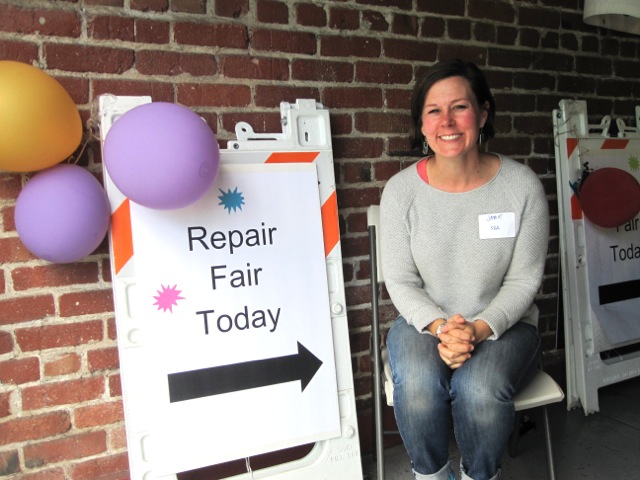
On May 17, Uptown Body & Fender in Oakland hosted the Repair Fair, an event single-handedly organized by volunteer Jamie Facciola, Community Engagement Planner with the Sustainable Business Alliance. For three hours, about a dozen Oakland businesses took turns demonstrating repairs on everything from shoes, amps and furniture to jewelry and vacuum cleaners. Meanwhile, on the far end of the spacious venue, a handful of volunteer “fixers” guided visitors in the disassembly and—in many cases—successful repair of broken stuff they had brought, including toasters, radios, hair dryers and even a doll.
Jamie had spent months pulling it all together. Her motivation? “After years of helping nudge big companies towards more ‘sustainable’ choices, I wanted to get involved in something tangible, something that has impact in my neighborhood.” Repair appeals to her because “it is an industry where growth doesn’t also mean growing resource depletion and waste, but actually means doing more good for the environment.”
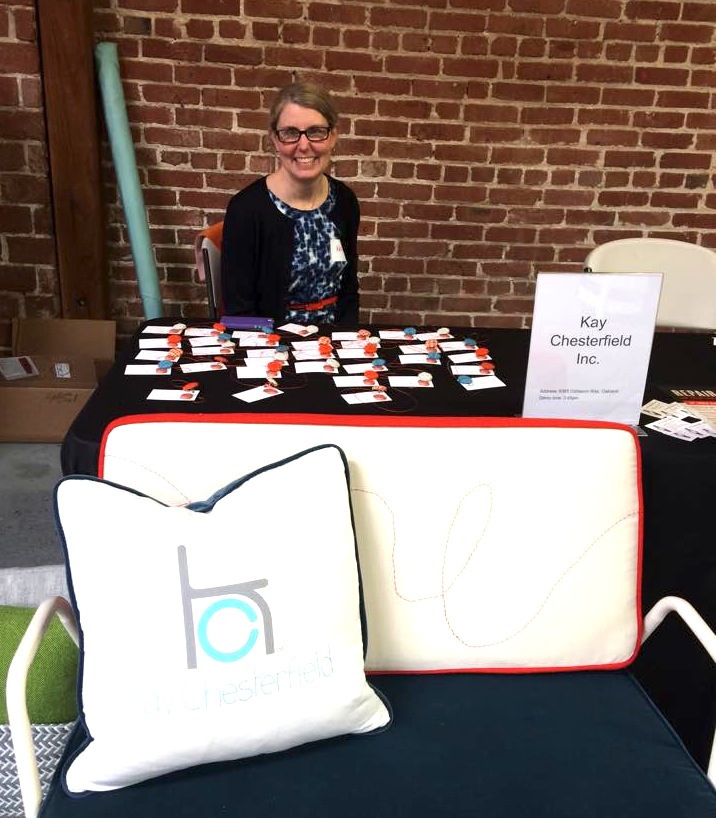
The point of the event was to promote local repair businesses, an industry that seems to be in danger of going extinct. Not that stuff breaks less—quite the opposite—but even items covered under warranty are no longer repaired because “it is the least incentivized option; typically a company will just send you a new one.”
The decline of repair seems ironic in a culture where the Maker Movement is thriving and DIY is hip, at least in the Bay Area. But there’s a difference. The appeal of the hugely popular Maker Faire, for example, is all about empowerment and creative self-expression in a world of cookie-cutter products. Repurposing definitely has its place there, but good old repair? Jamie speculates that maybe it’s just not sexy enough.
One of her biggest worries is that pretty soon repair services will only be available at Fixit Clinics where no money changes hands. “Don’t get me wrong—these pop-up events where volunteers gather to fix things for free are hugely popular and address a real need,” she asserts. “But I do wonder about the impact on the local economy.” At the event, she made a point of checking first if a visitor’s broken item could be handled by one of the repair businesses on hand before sending the owner over to the “fixer” corner.
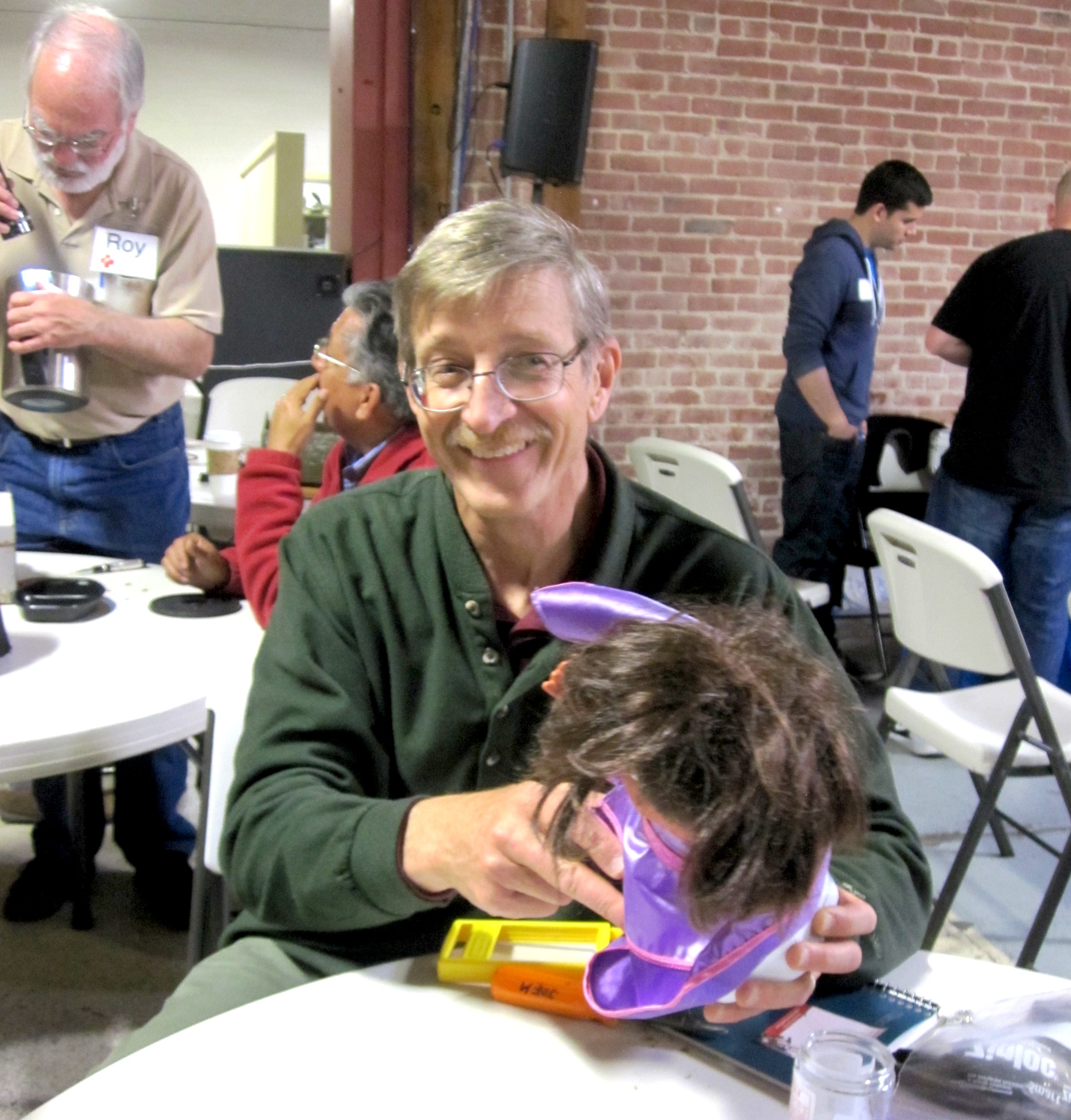
The event feedback from shops and attendees was overwhelmingly positive. Did they score new customers? Definitely, but more importantly, they met each other and networked, even referring visitors where their services weren’t quite the right match “Maybe they need to come together as a group, and market themselves as an industry,” muses Jamie. She is starting work on a business plan for a “Repair Salon”—a physical space shared by businesses offering one-stop shopping for repairs. “Oakland could be the perfect place for that.”
Follow Jamie’s next steps at repairrevolution.com or contact her by email.
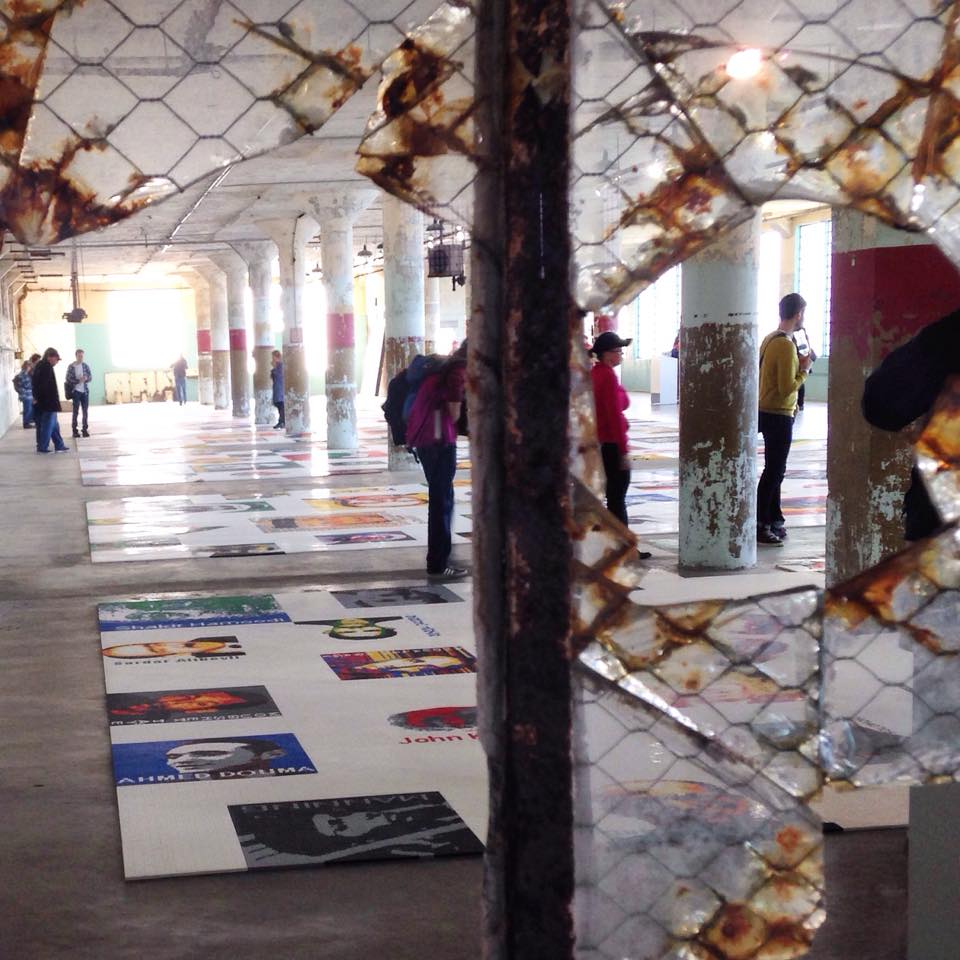 A stunning art installation featuring the plight of political prisoners around the world got me thinking about, yes, recycling campaigns. In addition to being a moving experience, the @Large exhibit by Chinese artist Ai Wei Wei , on now at Alcatraz Island, nicely illustrates the stages we consider when designing a campaign for environmental behavior change. The exhibit takes the viewer along a path, with different appeals and presentations at each step.
A stunning art installation featuring the plight of political prisoners around the world got me thinking about, yes, recycling campaigns. In addition to being a moving experience, the @Large exhibit by Chinese artist Ai Wei Wei , on now at Alcatraz Island, nicely illustrates the stages we consider when designing a campaign for environmental behavior change. The exhibit takes the viewer along a path, with different appeals and presentations at each step.
People need to come to behavior change through a process, most clearly described by Everett Rogers back in the 1960s in his book, Diffusion of Innovations. His Innovation Adoption Stages model looks like this:
Intentionally or not, the Ai Wei Wei installation follows the stages, leading the visitor from awareness of the issues, through “persuasion” via a multi-sensory deepening of the experience, and finally, offers a concrete action that the viewer can take.
The @Large installation begins at the New Industries Building. It takes several forms, but the initial contact focuses on making the viewer aware of the variety and extent of political imprisonment around the world. The floor of an enormous room is covered with portraits of political prisoners, made from LEGO bricks. At this point, the artist has not assumed that the viewer is ready to do something, but rather provides beautifully crafted “information” in the form of portraits of human faces arrayed across a huge space to raise awareness of the scope of the issue. Books detailing the stories of each of the prisoners are present, but the viewer is not in any way forced to learn more facts and figures. The act of walking the length of the huge room with the 176 portraits “sets the problem” in the mind and heart of the visitor.
The @Large exhibit continues to the cell block building, where the viewer starts to live into the experience of prisoners – visitors are invited to enter each of 12 small, unadorned and definitely not prettified cells. There is nothing to look at, but each cell has a different recording playing, usually of the music or speech of one of the prisoners. By involving the sense of hearing and the physical experience of walking into the tiny, dingy cells, the viewer becomes more fully involved and engaged.
After several more stops, at the end of the exhibition visitors are given the opportunity to write postcards addressed to individual prisoners whose portraits they saw earlier. The sponsoring Foundation notes: “The postcards are adorned with images of birds and plants from the nations where the prisoners are held. Cards are gathered and mailed by @Large Art Guides.”

The viewer has been led through awareness of the issue to persuasion about the problem’s scope and importance, though information and appeals to the emotions. Only at the end is the viewer invited to make a decision to act, by writing a personal communication to one of the prisoners introduced during the first stop of the exhibition. The viewer is not urged to act before s/he has had a chance to fully digest and explore the need to communicate. And by communicating, not to a general, amorphous authority, but to a single individual, the final action becomes that much more memorable.
Not all of our behavior change campaigns can be as beautiful and meaningful as Ai Wei Wei’s @Large, but there is much to admire in the intentional layout of the exhibit that aims to touch, inspire and ultimately, change the viewer. The exhibit ends this month…go see it if you can!
@Large: Ai Weiwei on Alcatraz is presented by the FOR-SITE Foundation in partnership with the National Park Service and the Golden Gate National Parks Conservancy.
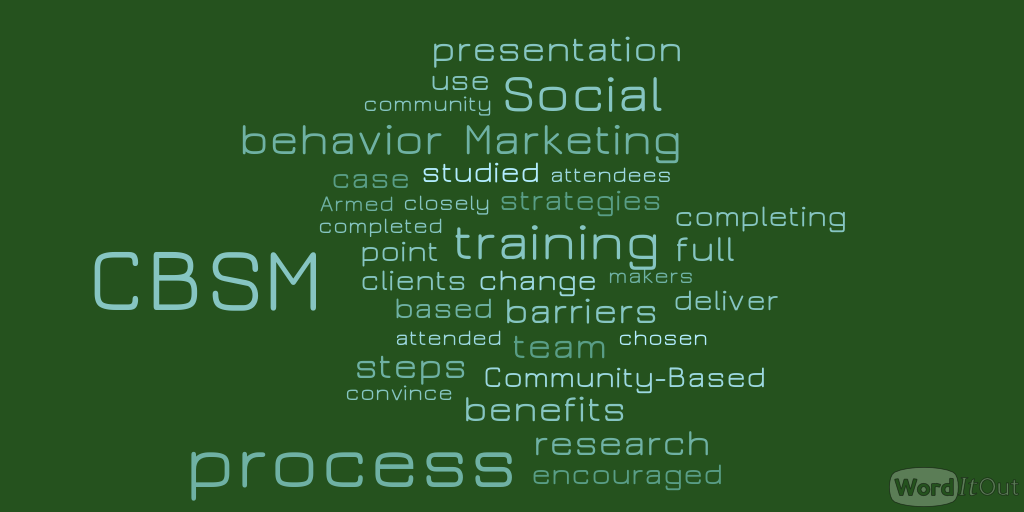 The Gigantic Idea Studio team attended the San Francisco Community-Based Social Marketing training in February. No, not THAT social marketing – there was no Facebook fanning or Twitter theory involved. Social marketing in this case is the process of encouraging behavior change for social good. In our case, that means fostering eco-friendly behavior such as recycling, waste reduction, preserving water quality, and so on. While our firm also employs other methods of promoting environmental programs and behaviors, CBSM remains the most studied and proven process for facilitating behavior change. While our team members have previously studied and practiced CBSM for years, we know it never hurts to take time for a refresher course in order to deepen our understanding.
The Gigantic Idea Studio team attended the San Francisco Community-Based Social Marketing training in February. No, not THAT social marketing – there was no Facebook fanning or Twitter theory involved. Social marketing in this case is the process of encouraging behavior change for social good. In our case, that means fostering eco-friendly behavior such as recycling, waste reduction, preserving water quality, and so on. While our firm also employs other methods of promoting environmental programs and behaviors, CBSM remains the most studied and proven process for facilitating behavior change. While our team members have previously studied and practiced CBSM for years, we know it never hurts to take time for a refresher course in order to deepen our understanding.
Perhaps the biggest point McKenzie-Mohr made during the training was that CBSM is a process, a full set of steps to follow to ensure you have the best chance at success. He was quick to point out that using one tactic on its own—doing a pledge or a prompt for instance—was not truly CBSM, if it wasn’t selected based on completing the steps of behavior identification, researching barriers and benefits, developing strategies and piloting.
It was an informative four days for our team at the trainings, where we worked closely in groups to practice CBSM techniques. We have always encouraged our clients to use the full CBSM process, but understand that sometimes budget and timing gets in the way. Fortunately, the training offered various options for completing the research and evaluation steps that make the CBSM process work, in ways that save money, but still allow for your strategies to be chosen based on actual information from your community.
Having completed the advanced training allows us access to McKenzie-Mohr’s CBSM presentation, and he encouraged attendees to deliver the presentation to key decision makers. Armed with the background on CBSM’s effectiveness, it is easier to convince funders, boards, managers and directors to approve outreach projects that use the full CBSM process. We would be happy to deliver this presentation to any of our clients!
 One of Gigantic’s core values, which we review each week in staff meeting, is staying light-hearted in the face of challenges. In our recent New Year e-blast, we decided to use humor to make a serious point: caring environmental changemakers come in many shapes, sizes and flavors, and we need every single one of them. We thought we’d demonstrate our theory of balanced teams by way of a popular current meme: the personality quiz.
One of Gigantic’s core values, which we review each week in staff meeting, is staying light-hearted in the face of challenges. In our recent New Year e-blast, we decided to use humor to make a serious point: caring environmental changemakers come in many shapes, sizes and flavors, and we need every single one of them. We thought we’d demonstrate our theory of balanced teams by way of a popular current meme: the personality quiz.
Admit it, you take them. We all take them. “Which Harry Potter character is your soul mate?” “Which Disney Princess are you?” “Which animal do you become at lunchtime?” They are addictive, fun, shareable and sometimes, quite revealing. So we created a quiz using a free platform called Playbuzz. For five questions, we created multiple-choice answers, with responses “keyed” to one of four different personality types:
[table id=3 /]
The answer choices were purposefully playful. “Where do you go to wash your car?” had the following possible responses, paired with their most likely personality types:
Practical Participant: “Self-service car wash business.”
Data Driven: “After careful analysis, I don’t wash it, We’re in a drought. I let Nature wash my car.”
Techie True Believer: “My car is treated with a superhydrotrophic coating – no need to wash it.”
Eco-Evangelist: “Car? What Car? One less car here.”
How did you score? Our Eco-Type list is by no means exhaustive. We know there are more gifts that other Eco-Types bring to the party. While we hope you are pleased with your result, the most important thing is that you had a moment’s fun, and that, while reading this post, you paused to think about your Eco-Team, and how their personality types can contribute to a more sustainable society.

A recent survey by the Consumer Electronics Association has some fairly depressing statistics (for example, 18 percent of consumers say they discarded electronics devices in the trash during the last year, a six point increase from 2012), but another result caught our eye: according to the survey, “nearly half of consumers (42 percent) first learned how to recycle their old devices by word of mouth from friends, family or co-workers.”
Surprising? Not at all. Study after study shows the importance of friends, family and co-workers on influencing all kinds of behavior. Nielsen’s 2013 survey of trust in advertising channels shows that 84% of respondents say word of mouth from family and friends was the most trustworthy form of persuasion. For those of us involved in green behavior change, this is good news, since we usually don’t have the budget for Coca-Cola-style mass media campaigns. However, word of mouth still needs to be made simple in order to get your ideas to spread.
So how to design campaigns that enhance the power of friends and family?
To enable word of mouth, we need to reach people, give them the information they need in an appealing, trustworthy and shareable form, and help them to feel that their sharing will be appreciated. A writer for Forbes describes this as the three E’s: Engage, Equip and Empower.
Of course, word of mouth alone cannot create behavior change, but it can be an important tool in a multi-touch campaign. Some questions to ask while designing our environmental behavior change campaigns include:
Are we being clear? Are we using terms that make sense to our audience? As we’ve seen in our research, it’s not a good idea to make assumptions about what people know about waste or water quality.
Are we providing the tools that people need to spread the word? People will be more likely to spread the word if they are equipped with catchy facts, a story, or shareable content. Is there such a thing as too many facts and data? For spreading messages, the answer is yes.
Have we asked for help? So simple, but so frequently overlooked. Just by saying “Let your neighbors know …” or “Please Retweet or Share,” your messages are more likely to be spread. Thanking people afterwards is even more powerful.
As we plan for new behavior change campaigns in 2015, the Gigantic team will be focused on fostering the thousands of individual conversations, both off and online, that will move us closer to a sustainable world. Let’s spread the word!

Shana McCracken and Lisa Duba co-founded Gigantic Idea Studio as one of the first marketing agencies dedicated to environmental outreach. After more than 13 years, Shana is moving on, and she leaves us now with some guiding thoughts as the Gigantic team continues this important work.
As my stint at Gigantic Idea Studio comes to a close, I can’t help looking back at the lessons I’ve learned. The big take-aways? Here are my top three for those working to promote environmental behavior change:
I could go on listing valuable lessons ‘til the proverbial cows came home, but I’m afraid it’s time for me to saddle up and mosey on down the trail. Good wishes and good outreach!
A typical set of curbside recycling instructions can leave residents confused. At this year’s California Resource Recovery Association/SWANA conference in San Jose, Gigantic Idea Studio presented an alternative approach: make it bite-sized.
To kick off our session on behavior change outreach and food waste diversion, Wendy Wondersort (aka our own Stefanie Pruegel) hosted the Sorting Game, with NorCal competing against SoCal to win the coveted Golden Pizza Slice. One team was given a long, complicated list of recycling instructions. The other received more straightforward directions. Can you guess who won?
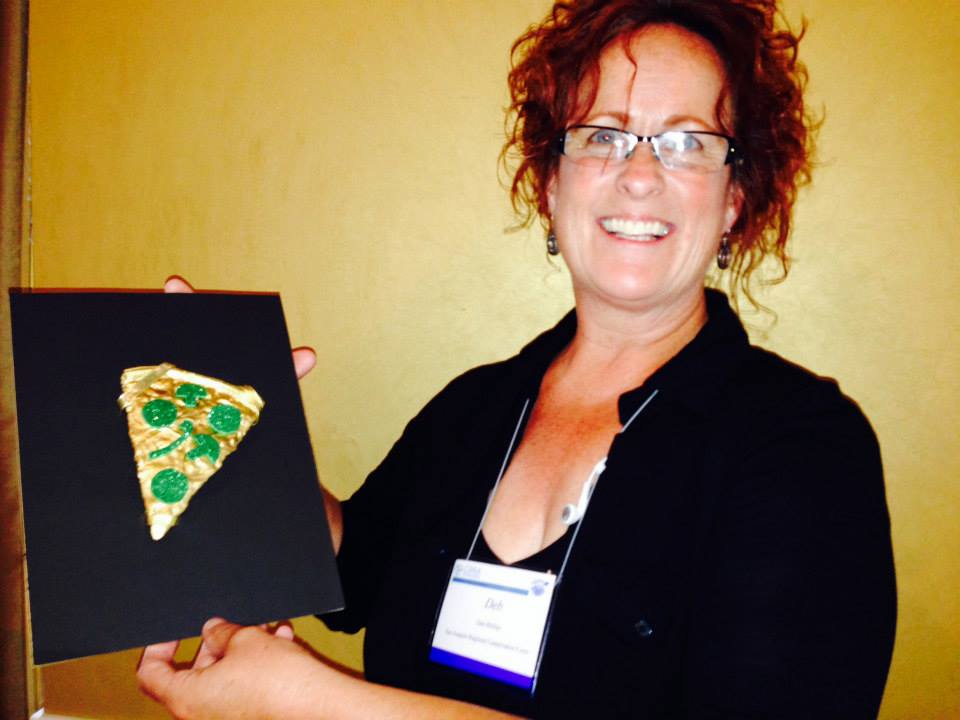
The Sorting Game helped us demonstrate how too many messages can lead to poor recycling outcomes. To show a real-world example, we presented the concept and results of a single material outreach campaign conducted with our partners at the City of Livermore earlier this year. This “bite sized” campaign focused on one material – pizza boxes – and used multiple tactics to reach residents. The simple instruction: pizza boxes go in the green cart.
To make our outreach message memorable, we created a “story line,” where Binny, the hungry green Organics cart, visits with a Livermore family as a dinner guest and craves the delicious pizza box once the family is finished eating.
The slideshow below goes into detail on the strategy and tactics of this multi-touch campaign, including partnerships with businesses and community organizations, creation of a 30-second video and accompanying contest, and a combination of online and offline tactics to ensure that residents got the message.
Early results show an increase in the number of pizza boxes correctly sorted and a greater confidence in proper disposal amongst residents surveyed. The City of Livermore has been a great partner, and we look forward to piloting more single-material campaigns in the future and continuing to share outcomes.
Questions?
There were many great questions at the end of our presentation at CRRA, and we wanted to share answers to a few of them:
What were ancillary benefits of the campaign?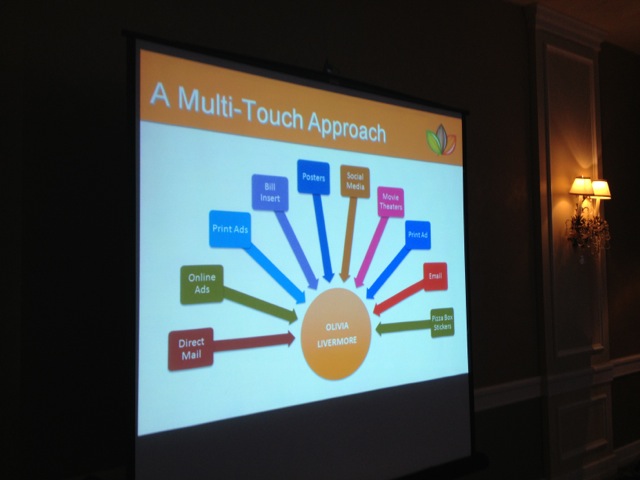
While focusing on one material, we were able to build a character and storyline around it that we can now leverage for other single-material campaigns. In addition to seeing some positive operational results, the campaign’s contest offered the opportunity to opt into receiving Livermore Recycles e-news updates; two-thirds of all contest entrants opted in to receive these news updates.
Is brand consistency between campaign and program recommended?
In general, it is a good idea to have a consistent look and feel for campaigns launched by an agency, and that was our strategy for this campaign. There may be instances when a more neutral or different campaign branding might be appropriate, if appealing to a segment like young people or those who might be distrustful or fearful of government agencies.
Could this type of campaign/strategy be scaled up to a regional or statewide level?
A bite-sized approach can be scaled up or down, depending on the target audiences. However, a regional or statewide campaign may need to consider leveraging additional or different tactics from a local campaign.
Do you think this type of campaign could be applied to business outreach?
Absolutely!
Resources
Here are some resources we recommend for further reading on behavior change theory:
Diffusion of Innovations, Everett M. Rogers
Fostering Sustainable Behavior, Doug McKenzie-Mohr
The Tipping Point, Malcolm Gladwell
Nudge, Richard Thaler and Cass Sunstein
Influence, Robert Cialdini
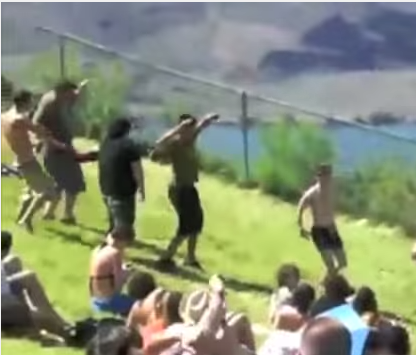 There’s a cool video that has been circulating for a few years, affectionately called the “Dancing Guy” video. “Dancing Guy” originated as a TED talk by Derek Sivers, and in a fairly short time the two official versions of the video have been viewed over three million times. Now used in M.B.A. programs to teach about entrepreneurship, it’s also got some great lessons for behavior change outreach:
There’s a cool video that has been circulating for a few years, affectionately called the “Dancing Guy” video. “Dancing Guy” originated as a TED talk by Derek Sivers, and in a fairly short time the two official versions of the video have been viewed over three million times. Now used in M.B.A. programs to teach about entrepreneurship, it’s also got some great lessons for behavior change outreach:
Here are three ways the shirtless Dancing Guy can help us with environmental outreach:
Be easy to follow. It’s easy to make behavior change outreach hard. All those exceptions, what-ifs, and “it depends” can get in the way of those who are ready to follow. When planning green outreach, see how you can prioritize the main behavior you want to promote, then simplify your message.
Nurture your first few followers as equals. For green behavior change, your first followers are usually idealistic, community-minded early adopters who want to help. Consider how you can enable them to spread the word about food scrap recycling, water conservation, or whatever your target behavior is, by providing tools, encouragement and eventually, recognition.
A movement must be public. Don’t hide your light under a bushel. In the case of your agency, that may mean getting out in the community by staffing events and talking to your constituents face-to-face. Or maybe it means engaging in social media conversations with other community organizations, or sponsoring a flash mob downtown.
That’s just a few of the lessons we see from the shirtless Dancing Guy – do you see others? In any case, here’s to the leaders, the first followers, and creating a movement that matters.
P.S.—For those of you skeptics out there, it looks as if the video really was not staged; see here.